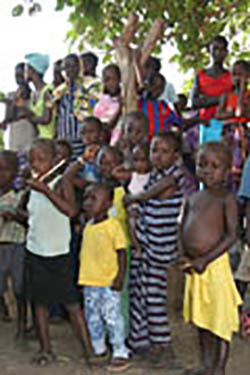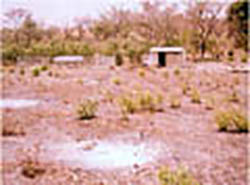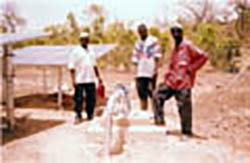Sutukoba rural agricultural and development project
Background:
Sutukoba is a big Mandinka village situated about 39 kilometres from the regional centre Basse in the northern part of Upper River Division in The Gambia. The population is estimated to be well over 3 000 inhabitants. 60 % of which are women.

The entire community is predominantly engaged in farming of upland crops, horticulture fruit trees and rain fed rice production.
The staple food is rice and coos. There is currently a rise in prices of food especially rice.
However, shortage of food was a common problem due to poor rains during the short rainy seasons. Four months of the rainy season which is Characterised by uneven rainfall results into crop failure and acute food shortage during the “hungry season”
(August and September). The people of rural Gambia especially in Sutukoba live a “hand to mouth” subsistence life. They expect a once-a-year source of cash income in Desember/January when they sell their cash crops. They have no other source of income except petty trading and the sale of small ruminants.
Justification:

A rural agricultural project for Sutukoba to be enlarged and developed in an existing 400 hectare perimeter which is suitable for rice production will immensely improve the standards of living especially harvesting at least four times a year. This will be based on rain fed rice production, and production through irrigation during the dry seasons.
The proposed area for the rice project is 3 kilometres from the village and is 50 meters from the River Gambia. The land area is a flat savannah, thus its development and enlargement will be financially reasonable.
Rice production, harvesting at least four times a year shall be one of the quickest solutions to securing food; generate income for the people of Sutukoba, the surrounding villages and the Upper River Division at large.
Goal:
To be able to cultivate rice in the 400 HA of land not only during the rainy season but also in the dry season. Improve rice production of farm families of Sutukoba so that they can be self sufficient in food and increase their incomes. Eventually to make Gambia self sufficient in rice which is the staple food of the country.
Who does what in the project?
The project will be administered in three levels ;
1. Aktive Fredsreiser – Travel for Peace
They will be responsible for the application in Norway and the control and disbursement of funds to the Gambia. Within this organisation there is a rice committee which will be responsible and they are as follows
HELGA ARNTZEN - Leader of the committee
UWE ARNTZEN - Assistant Leader
HUGO HANSEN- Financial Controller
2. Sutukoba Rice committee
This is the level on the ground in Sutukoba. They will be responsible for the day to day running of the field
They are the main beneficiaries of the project. At their level the field will be divided into two parts.
The first part will also be subdivided into smaller units amounting to the number families in the village. This is done specifically to enable the villages to grow their own rice to feed themselves.
The remaining is going to be a community project. The needed labour will be provided by the village and their committee will be responsible administering it. The main purpose of have this part of the project separated from the other is to use proceeds from this to sustain the project and invest into other village development activities. The compositition of the village rice committee is as follows;
MR MADI JATTA -Chairman
MS BINTOU FOFANA - Vice Chairperson
MR MORRO JATTA - Secretary
MR BA ARFANG JABBIE - Vice secretary
MR MAFULOU DIBBA SEY - Accountant
MS BABO JALLOW - Assistant Accountant
MS YOUKASSAY CAMARA - Aditor
MR FODAY JABBIE - Assistant auditor
MR WANDI DARBOE - Agricultural Adviser
Other village committee members without portfolio includes
MS JAKA JAITEH
MS KUMBA DANSIRA
MS ADAMA TOURAY
MS KATIDE TOURAY
MS MAMADING DANSO
MS KATIDE SAJAWO
MS KANI DANSO
The number of women in the committee at Sutukoba shows the importance of the role of women in the production of food in Africa and in particularly The Gambia.
As a control and monitoring mechanism, the Aktive Fredsreiser Peace Foundation in the Gambia have been given the responsibility of oversee the Sutukoba rice committee. There will be need for agricultural advice regard the different stages from the cultivation to harvesting of the rice. It is the responsibility of the foundation to be identifying and bringing experts to the field when the need arises.
In addition they will responsible facilitating the marketing of the rice upon harvesting.
Finally it is the responsibility of the foundation to see to it that the project works to expectations.
Their composition is as follows;
PROFESSOR ANDREAS STEIGEN Vice Chancellor , university of The Gambia
MR. LAMIN SAM JAITEH Registrar, University of The Gambia
DR. SAIDOU JALLOW Permanent Secretary, Department of State for Higher Education, Science and Technology.
DR. MOMODOU JAIN Senior Lecturer and Chair for Research and Strategy, university of The Gambia.
Objectives
- To establish and have an operational Agricultural scheme for active rice production, upland crops and horticulture.
- To assist rural subsistence farmers to develop to commercialized farming thus increasing agricultural production and eventually their income earning capacity. To acquire better knowledge and skills in crop and rice production in order to attain food security and self sufficiency through irrigation and larger scale farming.
- To strengthen community action planning, management, and mobilization for sustainability.
Historical developments in the Sutukoba rural agricultural dev. project
In 1994 the first rice project was tried. The rice came out nice to start with but flooding from the river coupled with heavy rains destroyed the entire crops.
This was followed by few other trials without much success. After a series of trials and seeking technical advice from relevant authorities, it was decided that growing rice using irrigation by getting water either from the river or through a boe-hole during the long dry season should be tried.
On the other hand creating a big wall between the river and the rice field have also been recommended and is part of the proposal. This will stop the water coming from the river flooding the rice field.
In this way it will be possible to cultivate and harvest rice four times in the year.
Initial activities time plan for phase 1
May 2003
Sensitization of Sutukoba farming community by Divisional Agric. Services (DAS) and introduce rice production in existing ecologies with set plan for the 2003 wet season of 20 ha. minimum inclusive with other crops and develop a cropping calendar.
June 2003
Land clearing and preparation for the rainy season programme and planting.
July 2003
Purchase of inorganic fertilizer and application using recommended rates. Monitoring and technical supervision by dept of Agric services in U.R.D.
Sept. 2003
Pre-and post harvest training techniques.
Oct. 2003
Harvesting, threshing, and drying eventually processing.
Nov./Dec 2003
Land development construction of irrigation system and demarcation and installation of irrigation pump and purchase of farm, machinery, implements and inputs.
Jan. 2004
Continuation of construction of irrigation system and cultivation of 1. phase of irrigation scheme on rice (Dry season crop). Nursery establishment.
Feb. 2004
Training of contact farmers to acquire knowledge and skills in recommended cultural practices and the concept of (IPM) Integrated Pest Management (6 days)
March 2004
Purchase of farm equipment (sprayer, pumps, and tractors)
May 2004
Complete initial construction and installations, develop a seasonal cropping calendar and land preparation for rice production area. Visits and monitoring of all activities technically.
Jan.2005
Training contact farmers for more participation and sustainability strategies planning.
Dec. 2006
Complete initial construction. Land fully developed for full scale production.

In 2006 GAMSOLAR was contracted for the drilling of the boe hoe, installing Solar pump with Solar panels for pumping of water into the rice field. The work was started but delayed because of delay in the importation of Solar panels.
This work have been completed and the pump is able to deliver about 180 000 litres of water per day. The small tank of 2000 litres is already in place for day to day water supply of the security personel. The 150 000 litres tank is yet to be constructed.
Budget (materials and equipment required for 400 hectares
| Seeds: Rice (250hax50kilosxD3) | D 37 500 |
| Land preparation (for year 1) | D 25 000 |
| Fertilizer (250bags) | D 175 000 |
| Monitoring and technical supervision | D 20 000 |
| Solar driven Boe-hole with Pumping machine | D 1 448 440 |
| Canals, floor and workmanship | D 261 000 |
| Rice treshers (5) x D 75 000 | D 275 000 |
| Security house and store | D 25 000 |
| Tractor with assessories (plough, harrow and planter) | D 200 000 |
| Hire of caterpillar (repair and maintenance of access road) | D 75 000 |
| Pipes (90 mm) for water distribution plus workmanship | D 595 000 |
| TRUCK (for transport of harvests from the rice field to the village and equipment and materials to the site) | D 1 150 000 |
| Tanks (small 2000 liters and big 150 000 liters for water storage) | D 595 000 |
| Cement, gravel sand and workmanship for the wall | D 631 200 |
| SUB TOTAL | D 6 613 640 |
| 10 % CONTINGENCY (of the totalt budget of D 6 613 640) | D 661 364 |
| GRAND TOTAL | D 7 275 004 |
The budget and the project as a whole have taken into account of environment. Fertilizer is going to being used but on a minimal scale. This is done to enable the soil to maintain its fertility for many years to come.
In addition fruit trees will also be grown as another remedy for the fertility of the soil. Above all the fruit trees will also supplement incomes to the farmers.
Source of funding
The only source of funding (D 1 804 945) so far have been Aktive Fredsreiser – Travel for Peace
What have been achieved as at now
Workmanship of the boe-hole have been completed with Solar panels for powering the pump.
The security house have been completed and a security personel employed for safeguarding the system especially the solar panels.
Cannels have been built for the distribution of water into the rice field. It have been anticipated that the cannels will not last long because of rain water or water from the boe-hole will undermind it and eventually causing it to crack and eventually lead to destruction. Thus the present cannel system for water distribution is a short term solution. As indicated on the budget a piping mechanism have been costed to eventually replace the cannel system.
6 Nursery beds have been planted and it is anticipated that these will be able cover an area of 12 HA of rice A tractor have been hired to plough the soil for the transplanting of the rice.
A tractor have been hired to plough the soil for the transplanting of the rice.
Expectations
It is anticipated that the first harvest of the currently planted rice which looks quite promising will take place in July 2008. Of the 12HA of land the harvest is expected to be about 60tons of rice.
Funding applied

The area covered in this initial phase is only 12 HA which is about 3% of the land intended for the first of the project. If funding is provided to cover the rest of the budget (D 5 470 059), then there will be the possibility of planting the entire 400 HA of land which will be able to accomplish the initial plan.
There is a further strategy to increase the area coverage from 400 HA to 2000 HA in other to eventually cater for the entire Gambia.
In view of the fact that the prices food have been increasing rapidly in the last two years and have even been worst the last six months. If this trend continues then it will be necessary for the entire project covering the 2000 HA to be done in one phase instead of two phases. This will need a further funding of D25 462 514.
This will be able yield a harvest of about 10 000 tons of rice yearly which will go a very long way in solving food needs in The Gambia.
The budget for the entire country will be around D 350 000 000. And if it includes sustaining it for the next 25 years then it will be about D 625 000 000. In this way Gambia will not only be able to self sufficient in food but also export to the sub region.
